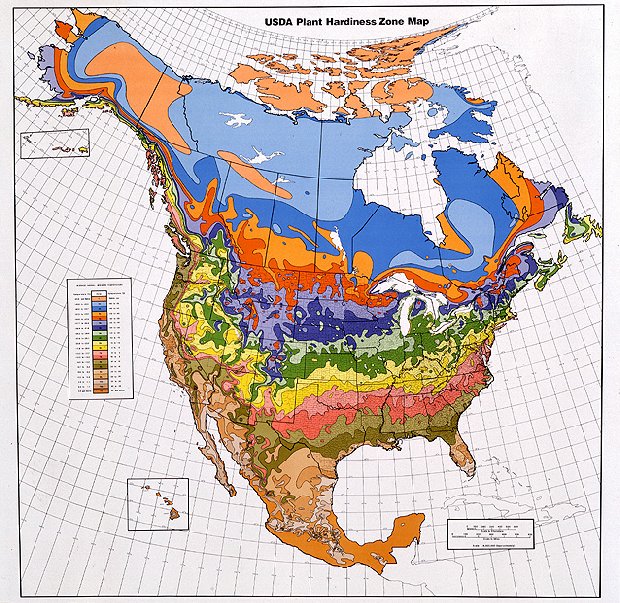|
|
||
|
||
| |||||||||||||
Locating Macroclimatic Predictors of Crop PerformanceWeather patterns at a regional scale (macroclimate) are at least somewhat similar from year to year. Different plant species are predictable in their ability to tolerate low winter temperatures, and in the length of the growing season and the amount of accumulated warmth they need to mature a crop. With this knowledge, plant scientists have developed two very important predictors of plant performance. Plant Hardiness Zones (PHZ) are based on the year to year predictability of minimum winter temperature. Growing Degree Days (GDD) are based on the heat requirements of different crop species. Plant Hardiness Zones (PHZ) The length of the growing season (average number of frost free days) and the average precipitation play important roles in how various NTFC species will perform at your site. It is the extremes of temperature, however, and in particular the minimum low winter temperature that ultimately will limit your choices. If a given species cannot tolerate the lowest winter temperature that is likely to occur, then it does not matter what the average temperature or precipitation level is. It probably will be a waste of your time to try to grow that crop. Below is a Plant Hardiness Zone Map developed by USDA from a national compilation of local weather records. It divides the US into 10 hardiness zones and each zone into 3 sub zones based on probable minimum winter temperatures. Information about the hardiness zone requirement (cold hardiness) is available for most species in the crop selection matrix developed for this course [link to matrix]. So knowing the plant hardiness zone for your site and the PHZ requirement for any species you wish to consider provides a good first cut in deciding what species are suitable to grow there.  North American Plant Hardiness Zone Map from the United States National Arboretum Website Click on the map to load the interactive version of the map.
Growing Degree Days (GDD)It is well known that a given crop takes longer to mature during a cool growing season than during a warm one. When the temperature drops below a certain critical temperature (usually assumed to be 50F) the crop will cease growing and not make any more progress towards maturation until the temperature again rises above that critical temperature. Growing Degree Days (GDD) are a measure of the total amount of heat above the critical 50F level, accumulated during the course of a growing season. This is a useful predictor of the time required to ripen many important agricultural crops. GDD also have been used to predict outbreaks of insects and disease so farmers can adjust the timing of appropriate control measures. In some areas the accumulation of GDD are carefully monitored by weather stations or other agencies on a county by county basis. In other areas the GDD are not at a local level, and it is necessary to rely on more general regional data. . GDD requirements for specific crops have been estimated and published for a number of woody crops including tree fruits, nuts and berries. If GDD requirement is available for particular NTFCs we have included this information in the crop selection matrix. For example, MacDaniels, 1981 (1) indicated that temperate nut crops (walnuts, hickory) require about 2250 GDD. From the GDD summary map provided in his publication Nut Growing in the Northeast, you can see in Ithaca, NY (center of Tompkins County shown on the map), that the MacDaniels Nut Grove lies on the isoline between 2250 and 2500 GDD. This means that it is highly likely that during cooler than average years nut crops will not have time to mature, but they would during higher than average years. Indeed this is the problem faced in cultivation of hickory nuts as a NTFC at that location. During cooler years nutmeats shrivel in the shell after post harvest drying because at the time of harvest, at the end of the growing season, they still have a relatively high moisture content and low oil content. Using the links below or similar sources for the region your site is in, find GDD data to fill out as much of the GDD table on page [9-10 ] as is practical.
References1. MacDaniels, L.H. 1981. Nut Growing in the Northeast. Plant Science. Floriculture and Ornamental Horticulture. College of Life Sciences and Agricultural Sciences, Cornell University. Bulletin 71. |
|||||||||||||
| << Previous : Next >> |
| Cornell Cooperative Extension ©2006 |

|